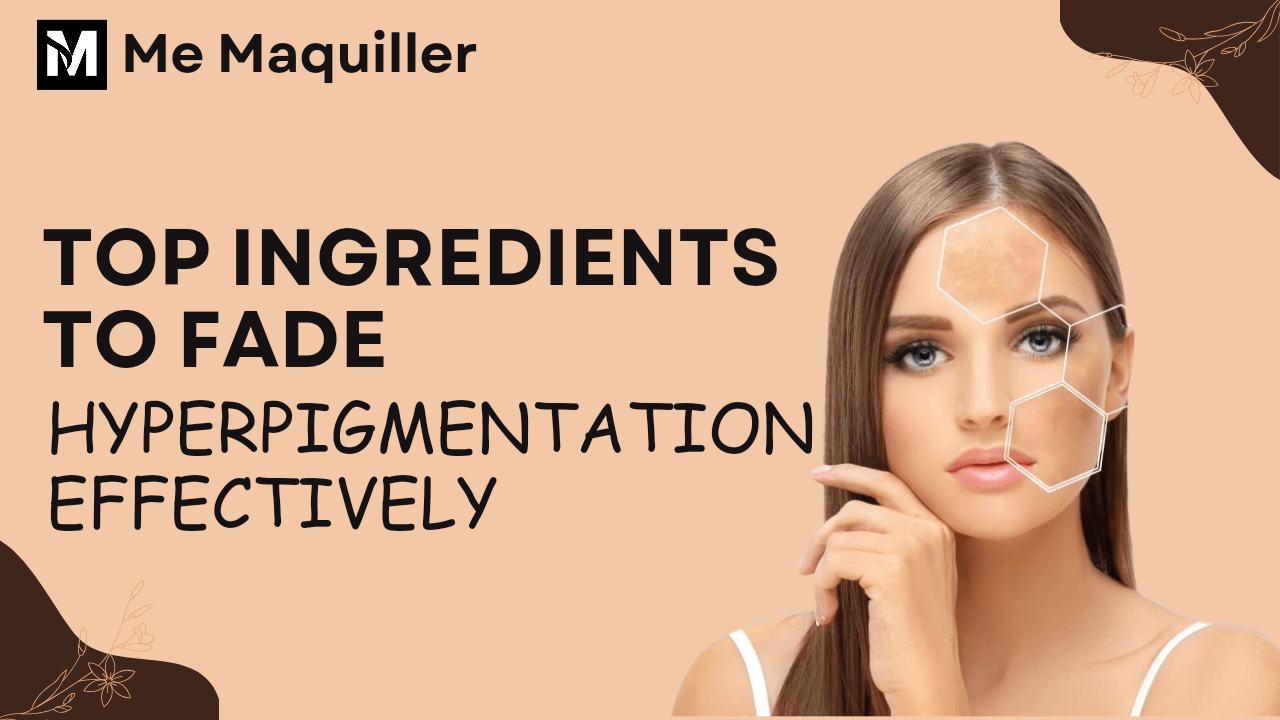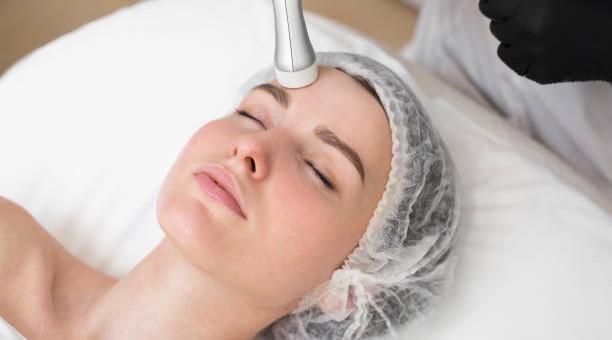Top Ingredients to Fade Hyperpigmentation Effectively
Sakshi Verma | 8 Nov,2024

In this Article
Introduction

Image credit to : iStocks
It is among the most prevalent skin issues, particularly in hotter climates like India. There are a number of treatments and natural solutions that can help even out your skin tone if you're wondering how to get rid of black spots on your face.
Hyperpigmentation is a common skin issue that may easily erode your confidence, but the right steps will surely treat it effectively. In the following guide, you'll be given practical and easy-to-follow strategies on how to even out your skin tone for healthier looking skin.
Dark spots & Hyperpigmentation
• Hyperpigmentation and dark patches have the same meaning due to excess melanin production. Melanin is the pigment responsible for your skin's color. There are certain triggers, however, that can cause too much melanin to be produced by the body, resulting in dark patches. Usually, skin spots and hyperpigmentation have the same texture as the skin and are not that painful.
• Dark spots can vary in size and show up on a variety of body parts. However, they are most prevalent where exposure to the sun is impending. These are common in people with darker skin as the spots are darker than usual.
Pigmentation
• Depending on how much melanin your body produces, pigmentation is a natural process that defines the colour of your skin, hair, and eyes.
Melasma
• A form of hyperpigmentation known as melasma manifests as blotchy spots that cover a greater region.
Causes of Hyperpigmentation
1. Sun Exposure
• It cause sunburn & can damage your skin cells and sun's ultraviolet(UV) rays can also damage the skin.
• The generation of melanin from the skin is a natural process, but too much sun exposure can cause it to be unevenly distributed, which can result in dark spots, melasma, and facial hyperpigmentation.
2. Inflammations
• Your skin becomes inflamed when you experience burns, blemishes, acne, or other skin injuries.
• Skin inflammation, also known as dermatitis, is a general term for skin irritation or swelling that can cause a range of symptoms like : Redness, Itching, Rash, Small blisters, Thickened skin, Pain, Allergens, Irritants, Bacterial, viral, or fungal infections, Extreme temperatures, Stress and Dryness.
• The skin frequently produces more melanin during inflammations, which results in discolouration and black patches.
3. Hormones changes
• Hormonal changes can cause the body to overproduce melanin, which leads to melasma and hyperpigmentation.
• Some causes of hormonal imbalance that can lead include: Pregnancy, Birth control and other hormone fluctuations.
• It's more common in women and can appear as blotchy patches on the cheeks, forehead, chin, or above the upper lip.
4. Genetic or Age
• Another common cause of hyperpigmentation is genetics. If your parents or grandparents have had dark spots or melasma on their skin, you are more susceptible to getting them too, one rare genetic disorder and also appears at the birth or in infancy.
• And with the age , the number of pigment-containing cells in the skin decreases, while the remaining cells increase in size.
5. Medication & Health condition
• Hyperpigmentation can result from both medical disorders and drugs. Drugs can create dark spots by inducing the production of melanin.
• Similarly medical conditions like addison disease, diabetes and lupus include can cause hyperpigmentation.
6. Acne
• Acne can cause hyperpigmentation, a condition known as post-inflammatory hyperpigmentation (PIH). Hyperpigmentation can result from even mild acne.
Steps to Manage and Reduce Hyperpigmentation
1. Prevent Further Damage by the Sun
The sun aggravates any existing dark patches and may also develop new ones. Thus, it's essential to have sunscreen as the first step of protection.
How to Protect Your Skin?
• Apply sunscreen with broad-spectrum SPF 30 or higher daily.
• Apply sunscreen every 2-3 hours, especially when outdoors or sweating.
• Choose physical sunscreens with zinc oxide or titanium dioxide for optimal protection.
• Use accessories like wide-brimmed hats and sunglasses to protect your skin.
• If you have melasma, use a tinted sunscreen that can block visible light, which is another activator of pigmentation.
2. Cleanse and Exfoliate Daily
Cleansing washes away dirt, oil, and makeup from your skin, while exfoliating helps remove dead cells to enable treatments to work more effectively.
How to Do It Safely?
• Wash your face with a gentle cleanser suitable for your skin type.
• Exfoliate once or twice a week with mild chemical exfoliants like alpha hydroxy acids (AHAs) or beta hydroxy acids (BHAs) to increase the rate of skin renewal.
• Caution: Avoid harsh scrubs or over-exfoliating, as this can irritate your skin and worsen hyperpigmentation.
3. Be Consistent and Patient
• Hyperpigmentation does not disappear overnight. It will take weeks to months for noticeable results, so consistency in your skincare routine is key. Stay the course and watch what happens over time.
4. 5 Ways to reduce Dark Areas at Home
Additionally, natural therapies might be able to lighten hyperpigmented spots. Nevertheless, no extensive human trials have been conducted to verify the efficacy of any of these treatments. Always try the any product on a small patch of skin first and stop using it if it irritates the skin.
(i) Aloevera
• It contains aloesin, a compound that may help to lighten reduce pigmentation. And Aloesin may also reduce hyperpigmentation by inhabiting tyrosinase, an enzyme that produces melanin.
• Apply fresh aloe vera gel directly to the skin before sleepling time at night and washoff in the morning.
(ii) Apple Cider Vinegar
• It contains acetic acid, which may help lighten dark spots by promoting cell turnover and balancing skin tone and apply it to the dark spots.
• Leave it on for about 10-15 minutes after washoff Its mild acidity can help exfoliate the skin.
(iii) Potato slice
• Raw potato contains enzymes, vitamin and minerals that may lighten skin and a slice apply to place & rub gently on the dark spots for about 15-20 minutes, then rinse off.
(iv) Gram flour & Turmeric mask
• Turmeric has anti-inflammatory and antioxidant properties and gram flour gentle exfoliant, removing dead skin cells and promoting a brighter complexion.
• Mix turmeric powder with gram flour to create a paste. Apply it to the skin, leave it on for about 20- 25 minutes, then scrubbing and rinse off.
(v) Tomato slice
• Tomato slices can help to reduce pigmentation. It contain lycopene, a powerful antioxidant that may help brighten the skin and reduce dark spots.
• Cut the fresh tomato thick slice, apply to place & rub gently on the dark spots for 15-20 minutes, and then rise off.
5. Treatment of serum
Topical acids serum can be effective treatments for hyperpigmentation. They work by exfoliating the skin, promoting cell turnover, and helping to fade dark spots. Here are some common types of topical acids serum used for hyperpigmentation.
1. Kojic acid serum
• Derived from fungi, kojic acid inhibits melanin production and is often used to lighten skin and reduce dark spots.
2. Alpha arbutin serum
• Tyrosinase, the enzyme that produces melanin, is inhibited by alpha arbutin. This lessens age spots and melasma, among other forms of hyperpigmentation.
3. Glycolic acid serum
• In addition to clearing up pores, glycollic acid also helps to lessen blackheads, acne scars, and dark spots.
6. Salon’s treatments

Image credit to : iStocks
Salon procedures for hyperpigmentation include:
• Laser therapy
• Chemical peels
• Hydra facial
• Intense plused light
Salon procedures can also lighten areas of skin to reduce the appearance of hyperpigmentation.
Preventing Future Hyperpigmentation
Preventing more appearance of dark spots can be just as important in doing so.
Top Tips in Prevention:
• Don't scratch or pick your skin, this can lead to the formation of post-inammatory hyperpigmentation.
• Drink water adequately, and hydrate to aid skin health.
• Eat a diet which is balanced and rich in antioxidants as exemplied by berries, spinach, and green tea for helping your skin.
• Manage Stress: High stress provokes changes in hormones that deteriorate pigmentation. One can maintain calmness by practicing yoga or meditation.
Simple Skincare Routine for Hyperpigmentation
Morning Routine
• Cleanser
• Vitamin C Serum
Evening Routine
• Cleanser
• Retinoid (if using) or Brightening Serum
Mistakes to Avoid
When treating hyperpigmentation, avoid these common mistakes:
(i) Missing Sunscreen: This cancels out all your hard work and lets pigmentation come back.
(ii) Overuse of Actives: Applying too many strong ingredients simultaneously can irritate your skin.
(iii) Instant Results: Treating hyperpigmentation requires time and patience.
(iv) Ignoring Professional Help: If OTC methods do not work, seek a dermatologist's advice.
Conclusion
A common skin problem that can affect people of any age or skin type is hyperpigmentation. But you can lessen and eventually get rid of them if you know what causes them and have the correct skin care regimen.
By following these steps and consistent efforts, you will signicantly reduce hyperpigmentation and have a more even skin tone. Don't forget to be patient and protect your skin from the sun and consult a professional when necessary. Time will reward your skin with a radiant glow!
FAQs
1. What causes hyperpigmentation?
Hyperpigmentation occurs when the skin produces too much melanin, the pigment that colors the skin. Causes include sun exposure, hormonal changes, acne scars, or injuries to the skin.
2. Does hyperpigmentation go away on its own?
In some cases, mild forms of hyperpigmentation, such as post inflammatory marks, will gradually lighten on their own. More persistent conditions, such as melasma or sunspots, often require consistent skincare or professional treatment to improve.
3. How long does it take to see improvements?
The duration for effectiveness varies with the severity and kind of hyperpigmentation. Supercial cases may notice some improvements in a matter of weeks, while more substantial pigmentation may take months. Adherence to a daily regimen ensures steady progress.
4. Does hyperpigmentation require sunscreens?
Yes. Sunscreen avoids UV rays from exacerbating current dark spots and promotes preservation of treated areas. It is an important part of maintaining and preventing hyperpigmentation.
5. Can hyperpigmentation be treated at home?
Many people would reply, 'yes', as various OTC products containing ingredients like niacinamide, vitamin C, or alpha arbutin, in a regular application basis can easily treat mild to moderate cases of hyperpigmentation.
6. Can home remedies like turmeric and aloe vera help?
Natural remedies can be kind to the skin, but they are usually not as effective as scientically proven treatments. For noticeable improvements, it is best to use active ingredients or consult a professional.
7. Does over-exfoliating worsen hyperpigmentation?
Yes, it can irritate the skin and cause inflammation, which may make dark spots worse. Only exfoliate 1-2 times a week with gentle products.
8. What ingredients are best for fading dark spots?
There is no one-size-ts-all solution, but effective ingredients include vitamin C, retinoids, azelaic acid, niacinamide, and tranexamic acid. Combining a few of these, with guidance, often delivers the best results.
9. Are professional treatments such as lasers and chemical peels safe?
Yes, these treatments, when performed by professionals, are safe and effective for the reduction of hyperpigmentation. Consulting a licensed dermatologist is always advisable to ensure that the treatment suits your skin type and needs.